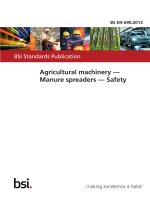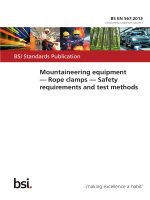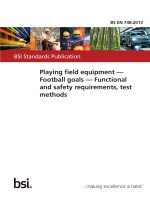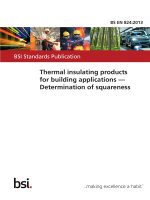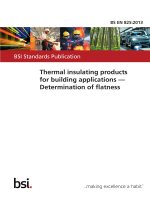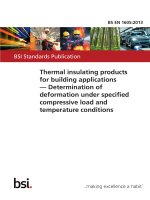Bsi bs en 16123 2013
Bạn đang xem bản rút gọn của tài liệu. Xem và tải ngay bản đầy đủ của tài liệu tại đây (1.04 MB, 26 trang )
BS EN 16123:2013
BSI Standards Publication
Characterization of waste
— Guidance on selection
and application of screening
methods
BS EN 16123:2013
BRITISH STANDARD
National foreword
This British Standard is the UK implementation of EN 16123:2013.
The UK participation in its preparation was entrusted to Technical
Committee B/508/3, Characterization of waste.
A list of organizations represented on this committee can be
obtained on request to its secretary.
This publication does not purport to include all the necessary
provisions of a contract. Users are responsible for its correct
application.
© The British Standards Institution 2013. Published by BSI Standards
Limited 2013
ISBN 978 0 580 71448 1
ICS 13.030.01
Compliance with a British Standard cannot confer immunity from
legal obligations.
This British Standard was published under the authority of the
Standards Policy and Strategy Committee on 28 February 2013.
Amendments issued since publication
Date
Text affected
BS EN 16123:2013
EN 16123
EUROPEAN STANDARD
NORME EUROPÉENNE
EUROPÄISCHE NORM
February 2013
ICS 13.030.01
English Version
Characterization of waste - Guidance on selection and
application of screening methods
Caractérisation des déchets - Lignes directrices relatives
au choix et à l'application des méthodes de dépistage
Charakterisierung von Abfall - Anleitung für Auswahl und
Anwendung von Screening-Verfahren
This European Standard was approved by CEN on 7 December 2012.
CEN members are bound to comply with the CEN/CENELEC Internal Regulations which stipulate the conditions for giving this European
Standard the status of a national standard without any alteration. Up-to-date lists and bibliographical references concerning such national
standards may be obtained on application to the CEN-CENELEC Management Centre or to any CEN member.
This European Standard exists in three official versions (English, French, German). A version in any other language made by translation
under the responsibility of a CEN member into its own language and notified to the CEN-CENELEC Management Centre has the same
status as the official versions.
CEN members are the national standards bodies of Austria, Belgium, Bulgaria, Croatia, Cyprus, Czech Republic, Denmark, Estonia,
Finland, Former Yugoslav Republic of Macedonia, France, Germany, Greece, Hungary, Iceland, Ireland, Italy, Latvia, Lithuania,
Luxembourg, Malta, Netherlands, Norway, Poland, Portugal, Romania, Slovakia, Slovenia, Spain, Sweden, Switzerland, Turkey and United
Kingdom.
EUROPEAN COMMITTEE FOR STANDARDIZATION
COMITÉ EUROPÉEN DE NORMALISATION
EUROPÄISCHES KOMITEE FÜR NORMUNG
Management Centre: Avenue Marnix 17, B-1000 Brussels
© 2013 CEN
All rights of exploitation in any form and by any means reserved
worldwide for CEN national Members.
Ref. No. EN 16123:2013: E
BS EN 16123:2013
EN 16123:2013 (E)
Contents
Page
Foreword ..............................................................................................................................................................4
1
Scope ......................................................................................................................................................6
2
Normative references ............................................................................................................................6
3
Terms and definitions ...........................................................................................................................6
4
Principles ................................................................................................................................................6
5
5.1
5.2
5.3
5.4
5.5
5.6
5.7
5.8
Typical areas for application of screening methods ..........................................................................7
General ....................................................................................................................................................7
Support of sampling/sample preparation processes.........................................................................7
On-site verification ................................................................................................................................7
Monitoring of processes .......................................................................................................................7
Identification of homogeneity/heterogeneity of bulk material ..........................................................7
Survey of contaminated sites (hot spot identification)......................................................................7
Identification of sources of contamination .........................................................................................7
Safety issue ............................................................................................................................................7
6
6.1
6.1.1
6.1.2
6.1.3
6.1.4
6.2
6.3
Selecting a screening method ..............................................................................................................8
Selection criteria ....................................................................................................................................8
Sampling/sample pretreatment/preparation .......................................................................................8
Parameter definition ..............................................................................................................................8
Field of application ................................................................................................................................8
Boundary conditions .............................................................................................................................8
Fit-for-purpose test ................................................................................................................................9
Quality targets ........................................................................................................................................9
7
7.1
7.2
7.2.1
7.2.2
7.2.3
7.2.4
7.2.5
7.2.6
7.2.7
7.2.8
Applicability conditions for screening methods ................................................................................9
General ....................................................................................................................................................9
Field of application ................................................................................................................................9
Principle of the measurement ..............................................................................................................9
Instruction for method setup ............................................................................................................. 10
Sampling and samples ....................................................................................................................... 10
Measurement steps ............................................................................................................................ 10
Statement of results ........................................................................................................................... 10
Disposal instructions ......................................................................................................................... 10
Characteristic data of the method..................................................................................................... 10
Literature references .......................................................................................................................... 11
8
8.1
8.2
8.3
8.4
Fit-for-purpose testing ....................................................................................................................... 11
General ................................................................................................................................................. 11
Reproducibility testing ....................................................................................................................... 11
Exclusion of false negative results ................................................................................................... 11
Testing of individual comparability .................................................................................................. 12
9
9.1
9.2
9.3
Analytical acceptance criteria ........................................................................................................... 12
General ................................................................................................................................................. 12
Starting criteria ................................................................................................................................... 12
Continuous criteria ............................................................................................................................. 12
10
Quality assurance ............................................................................................................................... 12
11
Documentation .................................................................................................................................... 13
Annex A (informative) Decision making process .......................................................................................... 14
2
BS EN 16123:2013
EN 16123:2013 (E)
Annex B (informative) Example of documentation aid/check list ................................................................ 15
Annex C (informative) Statistical tool for individual comparability – Equality of results from
reference method and screening method: Mean value t-test for real samples ............................ 18
C.1
General ................................................................................................................................................. 18
C.2
Test on outliers .................................................................................................................................... 18
C.3
Homogeneity of variances .................................................................................................................. 18
C.4
Mean value t-test ................................................................................................................................. 19
Bibliography ...................................................................................................................................................... 21
3
BS EN 16123:2013
EN 16123:2013 (E)
Foreword
This document (EN 16123:2013) has been prepared by Technical Committee CEN/TC 292 “Characterization
of waste”, the secretariat of which is held by NEN.
This European Standard shall be given the status of a national standard, either by publication of an identical
text or by endorsement, at the latest by August 2013, and conflicting national standards shall be withdrawn at
the latest by August 2013.
Attention is drawn to the possibility that some of the elements of this document may be the subject of patent
rights. CEN [and/or CENELEC] shall not be held responsible for identifying any or all such patent rights.
The standardization of the selection and application of screening methods is obligatory to make such methods
available to legislation. In addition to common laboratory methods, which are standardized individually, a
framework approach is chosen for screening methods. The application of screening methods within this
framework guarantees the reliability of results required by legal regulations.
In order to fulfil legal requirements, it is of high importance to document all decision steps of method selection,
the applicability testing, the application of the method and the evaluation.
This European Standard refers to the use of screening methods on solid materials (waste) as sample matrix;
the corresponding standard for water is ISO 17381.
According to the CEN/CENELEC Internal Regulations, the national standards organisations of the following
countries are bound to implement this European Standard: Austria, Belgium, Bulgaria, Croatia, Cyprus, Czech
Republic, Denmark, Estonia, Finland, Former Yugoslav Republic of Macedonia, France, Germany, Greece,
Hungary, Iceland, Ireland, Italy, Latvia, Lithuania, Luxembourg, Malta, Netherlands, Norway, Poland, Portugal,
Romania, Slovakia, Slovenia, Spain, Sweden, Switzerland, Turkey and the United Kingdom.
4
BS EN 16123:2013
EN 16123:2013 (E)
Introduction
This document provides guidance on the use of screening methods for waste characterisation. One field of
application of screening methods is “on-site verification” as recommended in the Landfill Directive
(1999/31/EC) and the Landfill Decision (2003/33/EC).
Screening methods are of increasing interest in processes such as entrance control because, in addition to
standardized methods, they allow fast verification of the documented waste characteristics.
5
BS EN 16123:2013
EN 16123:2013 (E)
1
Scope
This European Standard gives guidance on the selection and application of screening methods for waste
characterisation. The aim of this document is to set up criteria as to when the different kinds of screening
methods may be applied for the analysis of a certain parameter in waste and which steps are required to
prove their suitability.
This document does not recommend any particular screening method, but confirms the principles of its
selection and application.
2
Normative references
The following documents, in whole or in part, are normatively referenced in this document and are
indispensable for its application. For dated references, only the edition cited applies. For undated references,
the latest edition of the referenced document (including any amendments) applies.
EN 16192, Characterization of waste ― Analysis of eluates
3
Terms and definitions
For the purposes of this document, the following terms and definitions apply.
3.1
reference method
method which is performed in accordance with national or international Standards and is not necessarily
comparable with screening methods
3.2
on-site verification
third level of inspection according to the Landfill Directive and the Landfill Decision to ensure that the waste
accepted at a landfill is the same as described in the accompanying documents and that it is in accordance
with the basic characterisation and/or compliance testing
3.3
screening
application of any analytical semi-quantitative method for exploratory analysis
3.4
screening method
method which is used (often on-site) to quickly explore a given area or test a set of samples and obtain data
on sample characteristics
[SOURCE: ISO 12404, modified]
4
Principles
This standard defines the whole process from the selection of the screening method, applicability, fit-forpurpose testing, fulfilment of the acceptance criteria, quality control, and documentation of the measurement
results.
6
BS EN 16123:2013
EN 16123:2013 (E)
5
5.1
Typical areas for application of screening methods
General
Screening methods constitute a useful addition to standard procedures in the following areas.
5.2
Support of sampling/sample preparation processes
Screening methods may be used for:
selection of the most suitable analytical method (concentration range, interferences);
pre-selection of samples for analysis in the laboratory;
provision of information about accompanying compounds relevant for sample preparation.
5.3
On-site verification
Characteristics of sampled waste are verified, e.g. during transport or at the entrance of waste treatment
plants and landfills.
5.4
Monitoring of processes
Screening methods can be used:
to monitor and control processes (e.g. success of treatment processes);
to perform quality control on a treatment plant.
5.5
Identification of homogeneity/heterogeneity of bulk material
Screening methods may be applied to measure “leading” parameters in huge charges of waste to identify
whether the material is homogenous or not.
5.6
Survey of contaminated sites (hot spot identification)
Screening methods are useful to identify contaminated areas in contamination-suspected sites.
5.7
Identification of sources of contamination
Screening methods can be useful to identify the source of a contaminant or content in a material stream.
5.8
Safety issue
Screening methods can be used to detect potentially toxic compounds (e.g. gases, radioactivity, explosives)
which may be hazardous to the personnel taking and processing samples.
7
BS EN 16123:2013
EN 16123:2013 (E)
6
Selecting a screening method
6.1
Selection criteria
The following selection criteria should be taken into consideration when selecting the appropriate method. The
different criteria shall be weighted depending on the intended application. The decision-making process and
the results have to be documented by the user (see flowchart in Annex A and documentation aid in Annex B).
Prerequisites are:
one known parameter or a set of known parameters;
aim of determination;
matrix (solid/liquid waste).
6.1.1
Sampling/sample pretreatment/preparation
direct measurement (e.g. handheld XRF-systems);
pretreatment/preparation (e.g. extractions, separation) particularly for solid waste.
Most screening methods require the provision of the analyte in an extract/eluate, which therefore requires
sample pretreatment. Pretreatment shall be carried out in accordance with EN 16192.
If sample preparation is necessary, follow the principles of EN 15002 taking into account CEN/TR 16130.
6.1.2
Parameter definition
individual species (e.g. total Fe, Fe2+, Fe3+);
group parameters (e.g. total organic carbon (TOC), absorbable organically bound halogens (AOX));
in the case of on-site verification, the parameters are typically defined by declaration or based on the
experience of the staff.
6.1.3
Field of application
specified decision value (e.g. limit value, target value);
concentration range;
matrix;
method limitations/interferences.
6.1.4
Boundary conditions
rapidity (in relation to aim of determination);
mobility;
costs;
quality target of analysis;
8
BS EN 16123:2013
EN 16123:2013 (E)
frequency of use (continuous, once only);
qualification of staff;
legal stipulations;
availability and/or ease of acquisition;
infrastructural conditions.
6.2
Fit-for-purpose test
In a second step, after passing these selection steps in 6.1, the selected method has to pass a fit-for-purpose
test as described in Clause 8.
In case of frequently repeated tasks, the most suitable screening method should be identified and applied, the
necessary equipment kept ready and the procedure documented in a standard operation procedure. Selection
and fit-for-purpose testing has therefore to be performed only once.
6.3
Quality targets
The general quality target of analytical questions is its ability to establish the relationship between the
analytical result and its confidence interval on the one hand, and the decision values on the other. This
relationship with the decision values means that the analytical method to be used is subject to requirements
regarding the quality of the analytical results. These requirements are task-related and shall be defined before
the screening method is applied. The definition of these quality targets forms the basis for the selection of the
appropriate method.
7
Applicability conditions for screening methods
7.1
General
Availability of complete information on a screening method of choice is a prerequisite of applicability. This
clause deals with the most important points that should be apparent from the accompanying documentation of
a method. All information, either supplied or separately obtainable (enclosed leaflet, application documents,
etc.) shall be easily comprehensible and should be written in understandable language.
7.2
Field of application
parameters (e.g. total Fe, Fe2+, Fe3+);
measurement range/graduation; “zero” may not be stated for the lower limit of the operating range;
matrix;
matrix interferences, measures to be taken for their prevention or elimination;
temperature range, pH range, other physical conditions;
storage and shelf life of the reagents.
7.2.1
Principle of the measurement
chemical reaction or physical concept.
9
BS EN 16123:2013
EN 16123:2013 (E)
7.2.2
Instruction for method setup
description of supplied reagents (e.g. composition, indication of hazards);
description of supplied equipment, such as test vessel, metering device or colour scale;
description of how and with which measuring instrument the evaluation may be performed;
additional reagents required for the application (e.g. acid for pH adjustment);
additional equipment required for the application (e.g. thermo reactor for chemical oxygen demand).
7.2.3
Sampling and samples
description of sampling and of sample preparation;
description of sample quantity and volume.
7.2.4
Measurement steps
health and safety precautions;
handling; step-by-step (pictogram), introduction, training;
reaction time (interval);
ascertainment of results;
cleaning and maintenance instructions.
7.2.5
Statement of results
number of digits after the decimal point;
precision/accuracy;
conversion table, conversion factors;
recommended methods for assessment of results.
7.2.6
Disposal instructions
waste, waste water, hazardous waste;
return to the manufacturer.
7.2.7
Characteristic data of the method
calibration;
available certificate of analysis; reference to products for quality assurance by the user (control standard,
inter-laboratory tests).
10
BS EN 16123:2013
EN 16123:2013 (E)
7.2.8
Literature references
description of procedure;
additional information, examples of possible applications.
8
Fit-for-purpose testing
8.1
General
In general, fit-for-purpose testing means proving whether a method of choice provides results that are related
to the corresponding reference method. The intensity and type of fit-for-purpose testing depends on the quality
targets defined according to 6.3 and the type of screening technique used.
Three modules of testing may be applicable:
reproducibility testing;
exclusion of false negative results;
testing of individual comparability.
These three modules can be combined depending on the quality target. Reproducibility testing is always
required the first time a special test application is introduced.
Reproducibility testing can easily be combined with the testing of individual comparability.
Where the producer (or user) of the screening test publishes data of successful fit-for-purpose tests under
comparable conditions, these data may be referred to and may reduce the effort of the current test.
Where screening methods which deliver a concentration range or yes/no-results, instead of discrete values
only, reproducibility testing and evaluation of false negatives applies.
8.2
Reproducibility testing
One (or more) typical homogenised waste sample(s), containing a known amount of analyte (verified by use of
the reference method) is (are) analysed in six replicates, i.e. six complete approaches, by use of the screening
method. The data set is evaluated according to the quality target. The result of this testing can be used to
express the precision of the method.
In case of screening methods that only provide a concentration range or yes/no-results, the test should deliver
information whether the six replicates of the screening method always results in the same range or the same
yes/no-information.
8.3
Exclusion of false negative results
In many cases of application, the screening method is used to pre-select samples. In these cases, it is
important that the screening method does not give false negative results. False positives are not critical as in
these cases a control by reference method delivers clarification.
In order to test the probability of false negative results, a test scenario according to the quality targets has to
be designed.
Firstly, the precision has to be defined or derived from the actual precision (e.g. based on 8.2).
11
BS EN 16123:2013
EN 16123:2013 (E)
A set of typical samples covering the expected range of application is prepared (homogenised) and
characterised by the reference method. All samples are also analysed by use of the screening method.
The data are evaluated under consideration of the precision. The probability of false negatives is calculated.
The number of samples analysed depends on the required accuracy of the test. Ten typical samples are
considered the minimum.
In case of screening methods that only give concentration range or yes/no-results, the test should deliver
information regarding the number of false negatives of repeated measurements of the screening method.
8.4
Testing of individual comparability
One (or more) typical homogenised samples are prepared and analysed both by the screening method and
the reference method (six replicates).
The results are statistically evaluated according to the statistical procedure described in Annex C.
9
9.1
Analytical acceptance criteria
General
After a screening method has been proven to meet the given acceptance criteria, it may be used for the
defined purpose. Some of these criteria are to be checked before using the test (starting criteria); others have
to be continuously checked during the use of the method.
9.2
Starting criteria
Selection process according to Clause 6 successfully completed and documented.
Application criteria according to Clause 7 successfully evaluated and documented.
Quality targets defined according to analytical task and documented.
Individual fit-for-purpose scenario designed, successfully passed and documented.
Quality assurance measures and corresponding quality acceptance criteria defined (Clause 10) and
documented.
9.3
Continuous criteria
Continuous monitoring of quality acceptance criteria completed and documented.
In case of deviations from the quality criteria, measures have to be taken and documented. Use of method
may continue after re-covering quality criteria.
10 Quality assurance
Similar to routine procedures used in the laboratory, quality assurance of screening methods is subject to
various requirements, depending on the handling and nature of the method in question. In case of a method
used regularly (e.g. more than once per week), the quality assurance measures of the reference method may
be used.
These may include:
12
BS EN 16123:2013
EN 16123:2013 (E)
multiple testing;
measurements of standards and possible reference materials;
plausibility tests by standard addition;
comparative tests with reference methods;
interlaboratory tests.
Finally, the selection of suitable quality assurance measures depends upon the specific aim of the analysis.
The decision concerning the extent of the measures to be implemented, the results of these measures and
their assessment shall be documented.
11 Documentation
The application of this European Standard enables a qualified decision to be made regarding the most
appropriate method of analysis for the task at hand. At the same time, however, the decision-making process
shall be transparent and verifiable. For this reason, thorough documentation is especially important, starting at
the beginning of the test and lasting until assessment of the analytical results. Systematic documentation
provides objective proof of the quality of analysis.
The minimum requirements for documentation include:
presentation of decision criteria in accordance with Clause 6;
documentation of the qualifications of decision makers and personnel performing analysis;
documentation of individual quality assurance measures;
documentation of continuous quality assurance measures;
sampling record;
written report of the analysis, including:
indication of measured values with clear identification of samples;
indication of the equipment used;
deviations from the operating procedure, if applicable;
assessment of results;
pretreatment.
13
BS EN 16123:2013
EN 16123:2013 (E)
Annex A
(informative)
Decision making process
Figure A.1 — Flow chart
14
BS EN 16123:2013
EN 16123:2013 (E)
Annex B
(informative)
Example of documentation aid/check list
Short description of analytical task:
Definition of the quality target:
Selection criteria
Parameter definition
Relevance
please tick
Aspect
Applicability to
method
of
choice
Specified analyte:
Group or sum parameter:
Field of Application
Decision value:
Concentration range:
Matrix:
Expected interferences:
Method limitations:
Sampling, sample pretreatment
Direct measurement:
Sampling required:
Sample pretreatment required:
Eluate/Extract required:
15
BS EN 16123:2013
EN 16123:2013 (E)
Boundary conditions
Rapidity (in relation to aim of determination)
Mobility
Costs
Quality target of analysis
Frequency of use (continuous, once only)
Qualification of staff
Legal stipulations
Availability and/or ease of acquisition
Infrastructural conditions
Others:
Applicability conditions
relevant
16
condition
applied
Temperature range, pH range, other physical conditions
Storage and shelf life of the reagents
Chemical reaction or physical concept
Description of supplied reagents (e.g. composition, indications of
danger)
Description of supplied equipment, such as test vessel, metering
device or colour scale
Description of how and with which measuring instrument the
evaluation may be performed
Additional reagents required for the application (e.g. acid for pH
adjustment)
Additional equipment required for the application
Description of sampling and of sample preparation
Description of sample quantity
Health and safety precautions
Step-by-step (pictogram), introduction, training
Reaction time (interval)
Ascertainment of results
Maintenance instructions
Number of figures after decimal point
Precision/accuracy
Conversion table, conversion factors
Recommended methods for assessment of results
Waste, waste water, hazardous waste
Return to the manufacturer
Calibration
Available certificate of analysis
Description of procedure
Additional information, examples of possible applications
BS EN 16123:2013
EN 16123:2013 (E)
Fit-for-purpose testing
Relevance
please tick
Test type
Result summary
Test passed
Reproducibility
False negatives
Comparability
Quality Assurance measures
Apply
Measure
Measurements of
standards and
possible reference
materials
Plausibility tests
by standard
addition
Comparative tests
with reference
methods
Inter-laboratory
tests
Define measure and quality target:
Acceptance criteria
Selection process according Clause 6 successfully completed
Application criteria according to Clause 7 successfully evaluated
Quality targets defined according to analytical task
Individual fit-for-purpose scenario designed, successfully passed
Quality assurance measures and corresponding quality acceptance criteria defined (Clause 12)
Results:
Name of responsible person:
Date:
Signature:
17
BS EN 16123:2013
EN 16123:2013 (E)
Annex C
(informative)
Statistical tool for individual comparability – Equality of results from
reference method and screening method: Mean value t-test for real
samples
C.1 General
At least six sub samples of a representative homogenised material are analysed with both methods to be
compared under the same conditions.
C.2 Test on outliers
The results of both series are checked according to Grubbs test on outliers. One outlier per series is accepted.
The test value (TV) according to Grubbs is calculated as follows (Formula C.1):
TV =
X * −X
S
(C.1)
where:
TV is the test value;
X* is the single value (possible outlier);
X
is the mean value of a series;
s
is the standard deviation of a series.
The test value is compared with the tabled value rM (f = N; P = 95 %). Where the test value is higher than the
tabled value, the individual result under observation has been identified as outlier – and has to be eliminated
accordingly. Mean value and standard deviation are calculated by the remaining data again and the Grubbs
test is repeated. In case of detection of another outlier, the data series is not valid and a new set of data has
to be established (minimum number of valid data: 5).
C.3 Homogeneity of variances
The variances of both data series are checked according to the variances-F-test.
The test value is calculated according to Formula C.2:
TV =
(sS )2
(sR )2
where:
TV is the test value;
18
(C.2)
BS EN 16123:2013
EN 16123:2013 (E)
sS is the standard deviation of the screening series;
sR is the standard deviation of the reference series.
The result is compared with the corresponding tabled value for F-distribution (fv = Nv -1, fR = NR -1; P = 99 %).
Where the test value is higher than the tabled value a significant difference is proven. According to the current
variations, no comparability is found. Where the test value is lower or equal to the tabled value no significant
difference is found; i.e. the variation of the results is equal.
NOTE
Where the variance of the screening method is significantly lower than the variance of the reference method
the F-test is successfully passed.
C.4 Mean value t-test
After elimination of outliers the mean values of both data series are compared according to the mean value
t-test. The test value is checked by use of Formulae C.3 and C.4:
TV =
XR−XS
sd
⋅
NR ⋅ NS
NR + NS
(C.3)
and
sd =
(N R − 1) ⋅ sR2 + (N S − 1) ⋅ sS2
N R + NS − 2
(C.4)
where
TV is the test value;
X R is the mean value of reference series;
X S is the mean value of screening series;
NR is the number of data in reference series;
NS is the number of data in screening series;
sd
is the mean standard deviation from both series;
sR is the standard deviation of the reference series;
sS is the standard deviation of the screening series.
The mean standard deviation from both series is compared to the tabled value of the t-distribution
(f = NR + NS -2; P = 99 %).
Where the test value is higher than the tabled value, no equality of the compared data sets is given. Where
the test value is lower or equal to the tabled value, the result of the test is equality. Where the variation of the
screening method is significantly lower than the variation of the reference method it is allowed to use sR of the
reference method instead of sd in Formula C.3. Otherwise, a false non-equality may result. Depending on the
19
BS EN 16123:2013
EN 16123:2013 (E)
quality target of the analytical task, the user may be willing to change probabilities of the tests mentioned
above. In case of deviations, the argumentation has to be plausible and well documented.
20
BS EN 16123:2013
EN 16123:2013 (E)
Bibliography
[1] EN 15002:2006, Characterization of waste ― Preparation of test portions from the laboratory sample
[2] CEN/TR 16130:2011, Characterization of waste ― On-site verification
[3] CEN/TR 16176:2011, Characterization of waste — Screening methods for elemental composition by Xray fluorescence spectrometry for on-site verification
[4] ISO 12404:2011, Soil quality — Guidance on the selection and application of screening methods
[5] ISO/TS 13530:2009, Water quality — Guidance on analytical quality control for chemical and
physicochemical water analysis
[6] ISO 17381:2003, Water quality — Selection and application of ready-to-use test kit methods in water
analysis
[7] DIN 38402-71, German standard methods for the examination of water, waste water and sludge —
General information (group A) — Part 71: Equivalence of two analytical methods based on the
comparison of results and their statistical evaluation, Procedure for quantitative characteristics with
continuous set of values (A 71)
21
This page deliberately left blank
This page deliberately left blank
